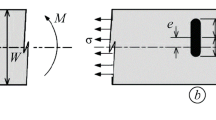Summary
Anchoring capacity of bone cement depends on the quality of the osseous bed. Experiments have demonstrated that smooth spongiosa is not suitable for a firm contact because necessary indentation is not obtained. The same applies to a roughened but blood covered surface of the osseous bed. The use of bone wax is of little help. The best method of anchoring acrylic bone cement consists in the preparation of deep holes and grooves in the osseous bed. It is doubtful whether radiating heat of the polymerization has any effect on the anchoring capacity of the bone cement.
Résumé
Des expériences concernant le problème du maintien des matières synthétiques dans l'os tendent à prouver que l'adhérence des plastiques autopolymérisant est sous la dépendance de la surface du lit osseux. Des surfaces spongieuses lisses empèchent la constitution de liaisons stables, car «l'indentation réciproque» n'est pas obtenue. Des adhésivités suffisantes pour la pratique ne sont également pas obtenues avec des surfaces ruguenses. Si la surface osseuse est recouverte de sang, l'adhérence diminue, tandis que l'utilisation de cire osseuse n'améliore que discrétement la stabilité. A cet égard, l'influence de la chaleur de polymérisation est mise en doute. Il semble que le meilleur moyen d'obtenir une combinaison solide est la confection mécanique de cavités et sillons profonds.
Zusammenfassung
Untersuchungen zum Problem der Kunststoffverankerung im Knochen sollen aufzeigen, daß die Haftung von autopolymerisierenden Kunstharzen von der Oberflächengestaltung des Knochenlagers abhängig ist. Glatte Spongiosaflächen eignen sich nicht für stabile Bindungen, da keine „Verzahnung“ erreicht wird. Für die Praxis ausreichende Verankerungen kommen auch an „gerauhter“ Oberfläche nicht zustande; Blutbenetzung führt außerdem zu Haftminderung. Knochenwachsabdichtung kann dabei die Haftung nur gering verbessern. In diesem Zusammenhang wird die Auswirkung der Polymerisationswärme in Zweifel gestellt. Als beste Verankerungsmaßnahme erweisen sich grob mechanisch geschaffene Bohrlöcher und Rinnen.
Similar content being viewed by others
Literatur
Burman, M., Abrahamson, R. H.: The use of plastics in reconstructive surgery. Lucite in arthroplasty. Milit. Surg. 93, 405 (1943).
Charnley, J.: Anchorage of the femoral head prosthesis to the shaft of the femur. J. Bone Jt Surg. 42-B, 28 (1960).
—— The bonding of prosthesis to bone by cement. J. Bone Jt Surg. 46-B, 516 (1964).
—— A biomechanical analysis of the use of cement to anchor the femural head prosthesis. J. Bone Jt Surg. 47-B, 354 (1965).
Charnley, J., Follacci, F. M., Hammond, B. T.: The long-term, reaction of bone to self-curing acrylic cement. J. Bone Jt Surg. 50-B, 822 (1968).
Contzen, H., Straumann, F., Paschke, E.: Grundlagen der Alloplastik mit Metallen und Kunststoffen. Stuttgart: Thieme 1967.
Harmon, P. H.: Arthroplasty of hip for osteoarthritis utilising foreign body cups of plastic. Surg. Gynec. Obstet. 76, 347 (1943).
Heidsieck, C., Bässler, R., Kohn, J.: Experimentelle Untersuchungen zur Frage der Knochenkonservierung im Kunststoff. Dtsch. zahnärztl. Z. 22, 518 (1967).
Hermann, K. O.: Die therapeutischen Ergebnisse zweier Fälle mit Kunststoffbehandlung von Frakturen des wachsenden Knochens nach Ablauf von 5 Jahren. Zbl. Chir. 88, 1258 (1963).
Hoffmann, K.: Feingewebliche Untersuchungen zur Verträglichkeit von Palavit im Tierversuch. Beilageheft Z. Orthop. 86, 352 (1955).
Hoppe, W.: Tierexperimentelle Untersuchungen über Gewebsreaktionen auf Injektion von autopolymerisierendem Kunststoff. Dtsch. zahnärztl. Z. 11, 837 (1956).
Huggler, A. H.: Die Alloarthroplastik des Hüftgelenkes mit Femurschaft- und Totalendoprothesen. Stuttgart: Thieme 1968.
Idelberger, K.: Palavit in der operativen Orthopädie. Beilageheft Z. Orthop. 86, 354 (1955).
Judet, J., Judet, R., Lagrange, J., Dunoyer, J.: Resektion — reconstruction de la hanche arthroplastic par prothèse acrylique. L'expansion scientifique française, Paris 1952.
Junghanns, H.: Operative Versorgung schwerer traumatischer Hüftgelenkveränderungen. Therapiewoche 19, 828 (1969).
-- Operative Behandlung von wirbelsäulenbedingten Wurzelsyndromen. Vortrag bei II. Rheumaseminar, Wiesbaden 1969.
Lange, M.: Orthopädisch-Chirurgische Operationslehre. Ergänzungsband: Neueste Operationsverfahren. München: Bergmann 1968.
Mittelmeier, H.: Gewebereaktionen bei der Allo-Arthroplastik des Hüftgelenkes. Langenbecks Arch. klin. Chir. 306, 163 (1964).
Müller, M. E.: Die Verwendung von Kunstharzen in der Knochenchirurgie. Arch. orthop. Unfall-Chir. 54, 513 (1962).
Oettel, H.: Biologische Probleme bei der Implantation von Kunststoffen. Langenbecks Arch. klin. Chir. 304, 900 (1963).
Ohnsorge, J.: Diskussionsbeitrag 87. Tagung Dtsch. Ges. f. Chir. 1.–4. 4. 1970.
—— Goebel, G.: Oberflächentemperatur des abhärtenden Knochenzementes Palacos beim Verankern von Metallprothesen im Oberschenkelmarkraum. Arch. orthop. Unfall-Chir. 67, 89 (1969).
—— Kroesen, A.: Thermoelektrische Temperaturmessungen des abhärtenden Knochenzementes „Palacos“. Z. Orthop. 106, 476 (1969).
Pfeiffer, R.: Fusion der Wirbelsäule mit dem Autopolymerisat Palacos. Arch. orthop. Unfall-Chir. 62, 205 (1967).
—— Ein neues Verfahren der Behandlung frischer Wirbelbrüche unter Anwendung eines Kunstharzes. Z. Orthop. 105, 122 (1968).
Scheuba, G.: Osteosynthese pathologischer Frakturen. Zbl. Chir. 90, 1737 (1965).
—— Die Osteosynthese mit dem Kunstharz Palacos. Chirurg 37, 506 (1966).
—— Zur operativen Behandlung von Knochenmetastasen in Gelenknähe. Wien. klin. Wschr. 80, 550 (1968).
Thomalske, G.: Die plastische Deckung von Schädelknochendefekten im Schnellverfahren nach Woringer. Med. Bilddienst 2, 3 (1962).
Willenegger, H., Schenk, R., Bandi, W.: Die Anwendung von Leimsubstanzen in der Knochenchirurgie. Melsunger Med. Mitt. 37, 2487 (1963).
Willert, H. G., Schreiber, A.: Unterschiedliche Reaktionen von Knochen und Weichteillager auf autopolymerisierende Kunststoffimplantate. Z. Orthop. 106, 231 (1969).
Author information
Authors and Affiliations
Rights and permissions
About this article
Cite this article
Kratzert, R., Schellmann, WD. Verankerungsprobleme bei der Anwendung autopolymerisierender Kunststoffimplantate. Arch orthop Unfall-Chir 68, 351–357 (1970). https://doi.org/10.1007/BF00416308
Received:
Issue Date:
DOI: https://doi.org/10.1007/BF00416308




